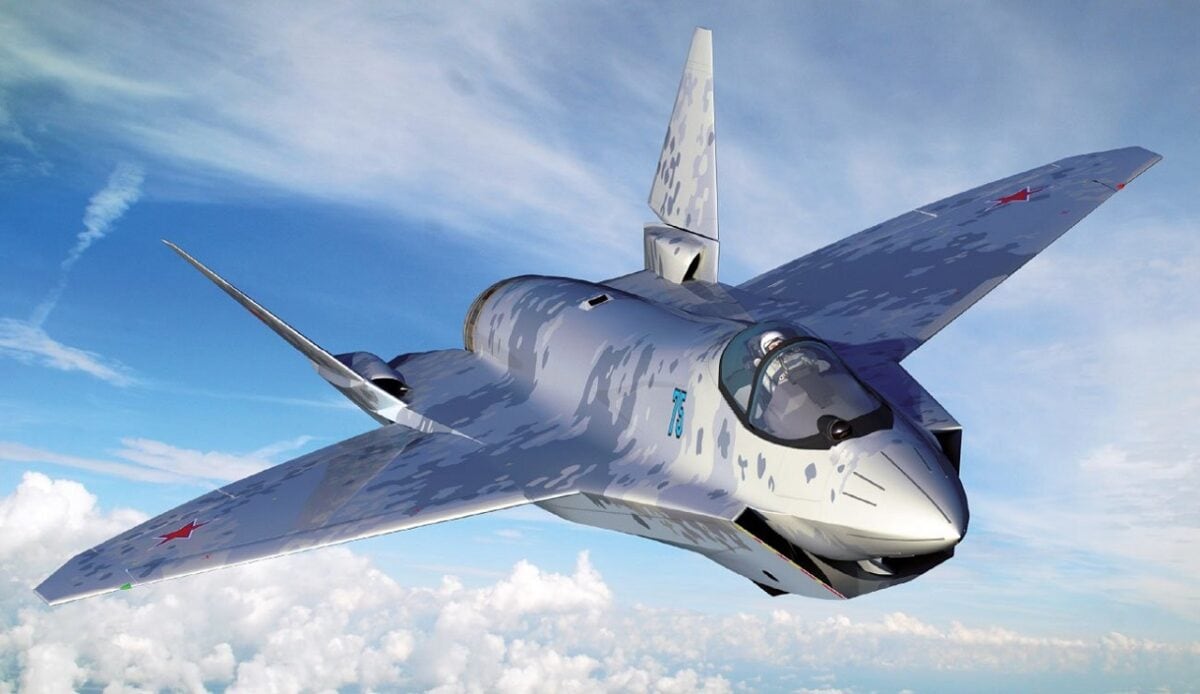Will the Su-75 “Checkmate” Reach Serial Production? – Earlier this month, it was reported that Russia’s highly-touted Su-75 “Checkmate” won’t make its maiden flight until at least some time in 2024 at the very earliest. However, the United Aircraft Corporation (UAC) – a division of the state-owned military-tech conglomerate Rostec – also announced that it would build four prototypes of the lightweight single-engine fighter in the coming months, with a goal to launch Checkmate serial production just three years later.
“We use advanced super-computer technologies in the Checkmate project, which enables us to cut substantially the timeframe of building the prototype and begin the flight tests already in 2024. Now preparations have been launched for the production of two prototypes. In all, we plan to build four prototypes,” UAC CEO Yury Slyusar told Tass earlier this month during the Army 2022 international military-technical forum, Russia’s largest military trade show.
The one advantage that Russia may have in ramping up production of the Su-75’s prototypes is that the bargain bunker aircraft utilizes equipment and components from the Su-57 (NATO Reporting name “Felon”), Russia’s fifth-generation stealth aircraft that has been in development for more than a decade. By “recycling” the R&D, and relying on components could be crucial to any effort to meet the Su-75’s tight timeline – yet, it should be noted that the Su-57 still has yet to reach full rate or serial production.
Su-75: Looking to the Export Market
UAC has claimed that steady progress has been made on the aircraft’s development since it was unveiled last summer at the MAKS 2021 international airshow outside of Moscow last summer. A mock-up of the aircraft, which was designed by UAC subsidiary Sukhoi Aircraft Company, was further displayed at the Dubai Airshow 2021 in the United Emirates (UAE) as an attempt to draw interest from potential foreign buyers.
UAC has also marketed the Su-75 as a derivative of the Su-57 fifth-generation fighter, which would be far more affordable than the American-designed Lockheed Martin F-35 Lightning II. Slyusar had told reporters that foreign customers have outlined their requirements for the Su-75 Checkmate fighter, and its further development will address those needs.
The single-engine fighter will reportedly incorporate stealth technology, as well as an internal weapons bay to carry air-to-air and air-to-surface missiles. That could indicate that the Su-75 could serve as both an air superiority and ground attack aircraft for nations with tight budgets.
The fighter can also carry a payload of more than 7 tonnes of armament and reportedly will be capable of striking up to six targets at a time. Other stealth characteristics include a hybrid wing body, a V-shaped tail, and an improved jet engine air intake with lighter mechanical systems.

Russia’s Su-75 Checkmate Stealth Fighter. Image Credit: Creative Commons.
Current specifications, which haven’t actually been put to the test or confirmed, also suggest the aircraft would have a top speed of Mach 1.8 and an operating range of 3,000 km. It will also have an open architecture configuration to meet the customer’s requirements and unique artificial intelligence technologies.
If it actually reaches full production, it could allow more nations to have a capable fifth-generation aircraft – but most experts would agree that the Kremlin’s claims that it would be comparable to the F-35 Lightning II, or that it could hold its own against the Lockheed Martin fifth-generation, are entirely misleading. The Su-75 could be a capable aircraft, and affordable alternative to the F-35 – but it still isn’t an F-35.

Su-75 Checkmate Stealth Fighter. Image Credit: Russian Government.
What the Experts Told 19FortyFive on Su-75
“I would argue that Russia will never build the Su-75 as there is likely little demand for such a jet after seeing Moscow’s performance in Ukraine,” explained a former National Security Council staffer in the George W. Bush Administration, speaking to 19FortyFive on background. “Looking at Russia’s pitiful performance in building the Su-57 and aircraft carriers in recent years, I would never give Putin a ruble for any of his garbage military equipment. History shows Russia comes in over budget and years late – and the military hardware may never work as advertised.”
Expert Biography: A Senior Editor for 1945, Peter Suciu is a Michigan-based writer who has contributed to more than four dozen magazines, newspapers, and websites with over 3,000 published pieces over a twenty-year career in journalism. He regularly writes about military hardware, firearms history, cybersecurity, and international affairs. Peter is also a Contributing Writer for Forbes. You can follow him on Twitter: @PeterSuciu.

